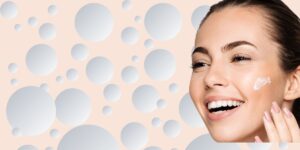Introduction – the Stratum Corneum
“The SC architecture is the most important factor in water flux and retention in the skin and in overall level of moisturisation.”1
Human skin is a multi-layered organ with a hard, thin outer layer called the startum corneum(SC). The SC is an inert structure not unlike a brick wall made up of nonviable (dead) cells. It is the function of the SC to maintain skin moisture levels by preventing water from escaping out and to protect the skin by preventing entry of harmful environmental factors from coming in. The SC is made up primarily of proteins and lipids (oils) and is impermeable to water and water soluble substances, much like a raincoat.
In order to maintain its flexibility, integrity, and critical catabolic activity the SC must remain hydrated, and in healthy skin the tissue contains greater than 10% water2. In the absence of water in the SC, skin becomes cracked, dry and brittle so it is important to maintain a water balance in the SC. The SC maintains optimum hydration levels through reducing water natural loss (called Transepidermal Water Loss (TEWL) through the skin due to environmental factors (heat, wind, sun etc.). Water in the SC is “bound” by a system called the Natural Moisturising Factor (NMF)2, a complex mixture of water-soluble compounds that serve to “bind” water in the SC. These compounds collectively prevent water from escaping the skin due to the desicating effects of the environment.
“The water held by the hygroscopic substances in the stratum corneum (SC) is a controlling factor in maintaining skin flexibility and desquamation.”4
Skin Hydration Processes
An understanding of the processes involved in hydrating the skin leads to a better understanding of skin hydration. The four key processes affecting SC function with regards to skin hydration are:
- Natural Moisturising Factor (NMF) process hygroscopically binds water in the SC
- SC Lipid (oil) layer protection process forms a layer to reduce water from escaping the skin
- Skin Desquamation or exfoliation process
- Physical Barrier (corneocyte) maintenance process
Each of these complex processes affects skin moisture levels and deficiencies in any process can lead to skin hydration problems.
“The type of emulsion and the selection of humectants, as well as other excipients, such as emulsifiers, lipids, chelators and preservatives, influence the skin barrier function.”3
Factors Affecting Skin Hydration
Maintaining moisture balance in the SC involves a complex interaction between water desiccating environmental factors and the chemical structures of the SC. Factors that affect this balance and therefore skin hydration levels include5:
- Maintaining the humectant balance of the NMF so that water is bound to the SC
- Maintaining the lipid (oil) balance of the SC which support a “water-proof” structure to prevent water escape
- Maintaining the exfoliation or desquamation process of the SC to prevent dry, flaky skin
- Relative humidity of the external environment
- Use of cleansing surfactants which deplete the lipid layer of the SC
- Use of emollient and/or occlusive agent which form a water retaining barrier on the skin6
- Increase intake of dietary of water to enhance skin hydration
“Emollients and moisturizing creams are used to break the dry skin cycle and to maintain the smoothness of the skin.”6
Some Terms Explained
The terminology used to describe skin hydrating and moisturising products can lead to confusion regarding selection of the best type of product to use. The following are most commonly used:
- Emollients – are mainly lipids (oils) used to hydrate, soften and smooth the skin to improve appearance and flexibility of the SC
- Occlusives – oils (such as petroleum or triglyceride oils) that form a barrier over the skin surface to reduce Transepidermal Water Loss (TEWL) water loss from the SC
- Humectants – hygroscopic, water soluble compounds such a glycerin and hyaluronic acid that bind water
- Moisturisers – term often used synonymously with emollient products and emollient products that also contain humectants
- Hydratants – term sometimes used to describe hydrating humectant-based products that may also contain emollients
“Occlusive and humectant ingredients work together to enhance epidermal hydration and barrier function.”1
Discussion
Maintenance of the moisture balance in the SC is critical to maintaining a healthy skin. Humectant water binding by components of NMF and emollient/occlusive action to retain water loss are both important factors. Using multifunctional products that support both functions can improve skin hydration. Our Green Micelle™ formulation system uses a micellar-based formula to combine natural emollient oils with natural water-soluble skin humectants to provide a more balanced treatment for dry skin conditions.
References
- 1.Kraft J, Lynde C. Moisturizers: what they are and a practical approach to product selection. Skin Therapy Lett. 2005;10(5):1-8. https://www.ncbi.nlm.nih.gov/pubmed/15986082
- 2.Harding C, Rawlings A. Effects of Natural Moisturizing Factor and Lactic Acid Isomers on Skin Function. In: Dry Skin and Moisturizers: Chemistry and Function. Dermatology: Clinical & Basic Science. Taylor & Francis, CRC Press; 2005:187-209.
- 3.Lodén M. Treatments Improving Skin Barrier Function. Curr Probl Dermatol. 2016;49:112-122. doi:10.1159/000441586
- 4.Loden M. Hydrating Substances. In: Handbook of Cosmetic Science and Technology. 3rd ed. Informa Healthcare; 2009:107-120.
- 5.Kilpatrick-Liverman L, Mattai J, Tinsley R, Wu J. Mechanisms of Skin Hydration. In: Handbook of Cosmetic Science and Technology. 3rd ed. Informa Healthcare; 2009:2291-106.
- 6.Lodén M. Role of topical emollients and moisturizers in the treatment of dry skin barrier disorders. Am J Clin Dermatol. 2003;4(11):771-788. doi:10.2165/00128071-200304110-00005












